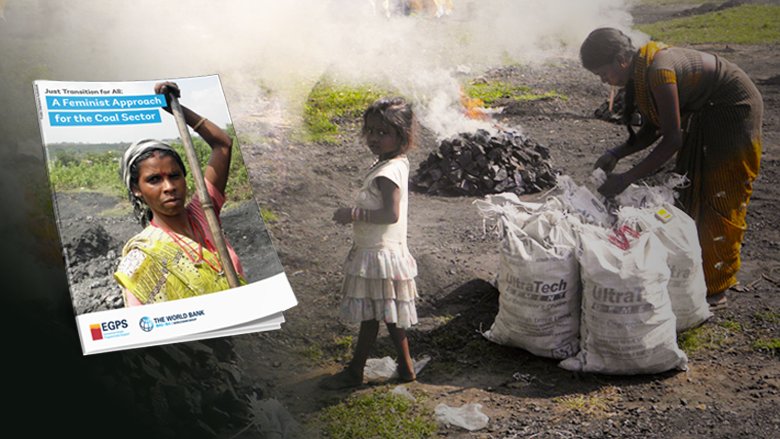Context:
Women account for a small share of the formal coal mining workforce, but are overrepresented in the informal, artisanal, and small-scale mining sectors. No matter the size or nature of the coal mine, women are generally poorly paid and typically engaged in low-level, informal, or daily-wage labor.
Most studies focus on how mine closures affect formal—often male—mine workers, overlooking social impacts on women—in their role as dependent spouses of laid-off miners, as workers in supply and secondary goods and service industries, and as members of communities facing economic decline.
A new World Bank report, Just Transition for All: A Feminist Approach for the Coal Sector, explores the gendered impacts of coal mine closure based on analysis of major coal-producing countries in the Global South. It suggests policies to help ensure that gender plays a central role in the planning process at the beginning of a just transition away from coal.
Main Findings:
- Women bear a greater share of the impacts of coal mine and thermal power plant closures because of gender roles and relations in coal mining communities. Because the industry has traditionally employed a handful of women directly, they cannot access employment and development programs that might be available to male workers who lose their jobs. Because women's roles in the coal-based economy are largely informal, "invisible," and unpaid, there is a risk that historical gender imbalances will be perpetuated, excluding women from opportunities in the new clean-energy economy. And because there is no perfect job substitutes in other non-mining sectors for laid-off mining sector workers, men are crowding in manufacturing and service industries, forcing women to shift to agriculture or other lower incomes livelihoods.
- When unemployment increases among male miners, women may experience higher levels of domestic violence, food insecurity, and a decline in status, with little potential for improvement. Spouses and partners of male mineworkers have less financial independence as coal communities are generally male-dominated. Therefore, when these male workers lose their jobs, their wives are often more adversely affected. Furthermore, women's lack of participation in higher-level, formalized, and decision-making spaces in coal communities means that their needs, interests, views, and perspectives are not considered in the policies that could improve their lives and increase their opportunities.
- Not all women are negatively impacted by the transition toward low-carbon technologies. Research shows that energy transitions can positively impact women's labor and living conditions. New technologies such as solar cooking stoves and solar lanterns will improve women's health and reduce the burden of manual tasks, such as collecting fuelwood for household use. However, women's labor participation in the renewable energy sector and in accessing the benefits accrued from new energy technologies remains highly contingent on prevailing gender norms and constraints.
- Local context matters. Regions where the coal sector is declining are widely divergent and so is the pace and significance of that decline. To be effective, all policy solutions must be based on careful analysis of local conditions and developed with the affected local communities. Other critical factors include effective consultation and collaboration between stakeholders and different levels and agencies of government. A recurring finding is that local levels of government that are the most severely impacted in terms of revenue by mine closure and are also charged with implementing transition programs must have the resources, capacity, technical skills, and support to implement gender-responsive transition policies and programs.
